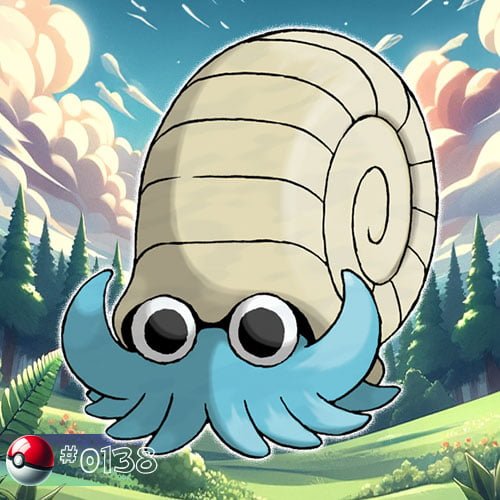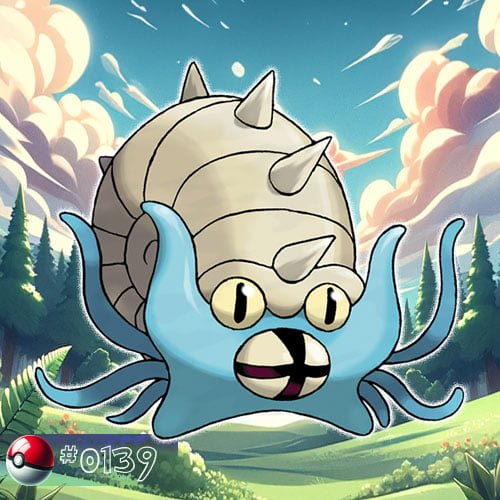Omanyte
Omanyte is a Rock/Water-type Pokémon species introduced in the Pokémon series. It resembles a small, ancient marine creature with a coiled shell on its back. It is known for its appearance in the fossil record and its ability to learn various water and rock-type moves.
Biology
Physical Characteristics
Omanyte is a prehistoric relatively small Pokémon compared to other Pokémon, typically measuring around 1 to 2 feet in height. Its compact size allows it to navigate through narrow spaces and hide within crevices.
Its most distinctive feature is its spiral-shaped shell, which serves as protection and support. The shell is composed of a hard, mineralized substance, giving it durability. Its body is primarily light blue, with a soft, fleshy texture. It has several tentacles protruding from underneath its shell, which it uses for movement and manipulation of objects.
Omanyte typically has large, round eyes that are often depicted as expressive and curious. Its eyesight is adapted to see in low-light conditions, ideal for its nocturnal habits. Located at the center of its body, Omanyte’s mouth is circular and contains rows of sharp teeth. This indicates its carnivorous diet, suggesting it feeds on small aquatic creatures.
The pattern on Omanyte’s shell resembles a helix, symbolizing its connection to ancient marine life. This spiral design is aesthetically pleasing and contributes to Omanyte’s unique appearance. As a fossil Pokémon, Omanyte’s physical characteristics reflect those of ancient marine organisms. Its shell and tentacles resemble those of extinct cephalopods, such as ammonites, which lived millions of years ago.
Overall, Omanyte’s physical characteristics combine elements of marine life and ancient fossils, making it a fascinating and visually striking Pokémon.
Behaviour
Omanyte, like many Pokémon, exhibits a range of behaviors influenced by its natural instincts and environment. Here are some details about Omanyte’s behavior.
Omanyte is primarily an aquatic Pokémon, preferring to dwell in shallow coastal waters or ocean floors. Its behavior is adapted to marine life, and it is often found in areas rich in aquatic plants and prey. Omanyte is known to display curiosity towards its surroundings, investigating objects or creatures it encounters with its large, expressive eyes. This behavior suggests a level of intelligence and awareness, as Omanyte explores its environment and learns about the world around it.
Omanyte is primarily nocturnal, meaning it is most active during the night. This behavior likely helps it avoid predators and conserve energy during the day, when it may rest or seek shelter in rocky crevices.
As a carnivorous Pokémon, Omanyte hunts small aquatic organisms for food. It uses its tentacles to capture prey, employing stealth and agility to ambush unsuspecting targets. Omanyte’s sharp teeth are well-suited for tearing flesh, allowing it to consume its prey efficiently.
Omanyte is believed to have a solitary lifestyle, preferring to roam and hunt alone rather than in groups. However, during certain times, such as breeding seasons or when resources are abundant, Omanyte may congregate in small groups.
Omanyte’s spiral-shaped shell serves as more than just protection; it also plays a role in its behavior. When threatened or alarmed, Omanyte can retract into its shell, using it as a shield against predators. This behavior allows Omanyte to defend itself from potential threats until the danger has passed. As a fossil Pokémon with origins dating back millions of years, Omanyte may exhibit behaviors reminiscent of its ancient ancestors. While modern Omanyte may not face the same environmental pressures as its prehistoric counterparts, it retains instincts and behaviors shaped by its evolutionary history.
Overall, Omanyte’s behavior reflects its adaptation to an aquatic lifestyle, with hunting, defense, and exploration among its key behavioral traits.
Evolution
Omanyte undergoes a single-stage evolution into Omastar. Here’s a detailed overview of its evolution.
Omanyte, along with its counterpart Kabuto, is a fossil Pokémon that can be revived from a Helix Fossil. In the Pokémon world, these fossils are ancient remnants of Pokémon that lived millions of years ago. Trainers can take these fossils to certain locations, such as the Cinnabar Island Laboratory in the Kanto region, to have them restored into living Pokémon.
Once a Trainer obtains a Helix Fossil, they can bring it to a Pokémon Laboratory or a similar facility dedicated to fossil restoration. Scientists use advanced technology and techniques to extract genetic material from the fossilized remains and reconstruct the Pokémon’s body and DNA.
After Omanyte is revived from the Helix Fossil, it remains in its Omanyte form until it reaches a certain level of experience through battles and training. Once it meets the conditions for evolution, typically around level 40, Omanyte evolves into Omastar.
The evolution from Omanyte to Omastar brings about significant morphological changes. Omastar’s body structure differs from Omanyte’s, featuring a larger, more pronounced shell with distinct spikes and ridges. Its tentacles may also change in appearance, becoming longer or more segmented. Omastar, the Pokémon gains increased strength, durability, and potentially new abilities compared to its pre-evolved form. Omastar’s evolution may also result in changes to its typing, movepool, and overall stats, making it a more formidable opponent in battles.
Omastar’s evolution reflects its adaptation to its aquatic habitat. Its evolved form may possess traits and abilities that allow it to thrive in underwater environments, such as enhanced swimming capabilities, improved defense mechanisms, or specialized hunting techniques.
The process of fossil revival and evolution adds depth to the lore surrounding fossil Pokémon like Omanyte and Omastar. Trainers may learn about the ancient history of these Pokémon, their role in the ecosystem, and the scientific advancements that enable their resurrection in the modern era.
Overall, Omanyte’s evolution into Omastar represents a significant milestone in its life cycle, marking its transition to a more powerful and specialized form suited to its aquatic lifestyle.
Appearances
Anime Main Appearances
In “Attack of the Prehistoric Pokémon” Ash encountered several Omanyte alongside other Fossil Pokémon awakened by a dynamite blast. Later, in “Fossil Fools” Omanyte were found in the Ruins of Alph, relocating to a museum by episode’s end. In “Dealing With Defensive Types!”, an Omanyte caught Team Rocket pilfering food from Canalave Gym’s kitchen, thwarting them with Water Gun during Ash’s Gym battle with Byron.
Anime Minor Appearances
In “The Ultimate Test” dub, an Omanyte was depicted in an image. Omanyte was also featured in the Japanese credits of “Pikachu’s Rescue Adventure” and appeared in a fantasy in “A Ruin with a View”.
In “A Gruff Act to Follow!” one Omanyte was revived from a Fossil and was later seen in a habitat with other revived Fossil Pokémon. Three Omanyte resided in the Tree of Beginning in “Lucario and the Mystery of Mew” with another in the movie’s opening sequence.
A Mirage Omanyte appeared in a flashback in “The Mastermind of Mirage Pokémon”. Additionally, an Omanyte was seen underwater near Vermilion City in “Legend? Go! Friends? Go!” and in “Restore and Renew!”.
Manga Appearances
Pokémon Adventures
Misty bestowed her Omanyte upon Yellow in “As Gastly as Before” dubbing him Omny. He eventually evolved into Omastar in “The Might of…Metapod?!”. Additionally, an Omanyte was spotted at the Battle Pike in “Moving Past Milotic”.
Pokémon Pocket Monsters
In this manga Omanyte owned by Green made its first appearence in ”The Big Battle In The Viridian Forest!!”.
Various Omanyte appeared in:
- ”Big Rampage at the Safari Zone!?” (evolving into an Omastar)
- ”Regain the Deserted Power Plant!”
- ”Good Luck at the Big Pokémon Athletic Meet!”
- ”Fierce Competition at the Pokémon Baseball Tournament!” (participated in a baseball match)
- ”Clefairy Evolves… At Last?!”
- ”Pikachu’s Birthday Party”
- ”The Ancient Pokémon Discovery!”
Game data
Stats
Location
| Game version | Location |
|---|---|
| Pokémon Red and Pokémon Blue | Cinnabar Island |
| Pokémon Yellow | Cinnabar Island |
| Pokémon Gold and Pokémon Silver | Time Capsule |
| Pokémon Crystal | Time Capsule |
| Pokémon Ruby and Pokémon Sapphire | Trade |
| Pokémon FireRed and Pokémon LeafGreen | Cinnabar Island |
| Pokémon Emerald | Trade |
| Pokémon Colosseum | Trade |
| Pokémon XD | Trade |
| Pokémon Diamond and Pokémon Pearl | Oreburgh City |
| Pokémon Platinum | Oreburgh City |
| Pokémon HeartGold | Pewter City |
| Pokémon SoulSilver | Trade |
| Pokémon Black and Pokémon White | Nacrene Museum |
| Pokémon Black 2 and Pokémon White 2 | Nacrene Museum |
| Pokémon X | Trade |
| Pokémon Y | Ambrette Town Fossil Lab |
| Pokémon Omega Rubya | Trade |
| Pokémon Alpha Sapphire | Rustboro City |
| Pokémon Sun and Pokémon Moon | Trade |
| Pokémon Ultra Sun and Pokémon Ultra Moon | Route 8 |
| Pokémon: Let's Go, Pikachu! and Pokémon: Let's Go, Eevee! | Cinnabar Island |
| Pokémon Sword and Pokémon Shield | Trade |
| Pokémon Brilliant Diamond and Pokémon Shining Pearl | Oreburgh City |
| Legends Arceus | Unobtainable |
| Pokémon Scarlet and Pokémon Violet | Unobtainable |
Omanyte's origin name
English: Omanyte’s name in English is a combination of “ocean” and “ammonite,” referencing its design inspired by the extinct marine mollusk called ammonites. Here’s its name in other languages:
Japanese: Its Japanese name is オムナイト “Omunate,” which is a combination of “omu” (from “ammonite”) and “night” (likely referring to the dark depths of the ocean where ancient fossils are found).
German: In German, it is known as “Amonitas,” which is a direct adaptation of its English name, “Ammonit” being the German word for “ammonite.”
French: Omanyte is called “Amonita” in French, following a similar pattern as its German name, derived from “ammonite.”
Spanish: Its Spanish name is “Omanyte,” identical to its English counterpart.
Italian: In Italian, it is known as “Omanyte,” again mirroring its English name.
Korean: Omanyte’s Korean name is “오므나이트” (Omneiteu), which closely resembles its English name.
Chinese (Simplified): In Simplified Chinese, it is written as “菊石獸” (Júshíshòu), where “菊石” (júshí) means “ammonite” and “獸” (shòu) means “beast” or “creature.”
Chinese (Traditional): In Traditional Chinese, it is also written as “菊石獸” (Júshíshòu).
These names maintain the essence of Omanyte’s inspiration from prehistoric ammonites while providing variations suitable for different linguistic and cultural contexts.




